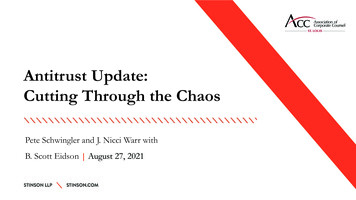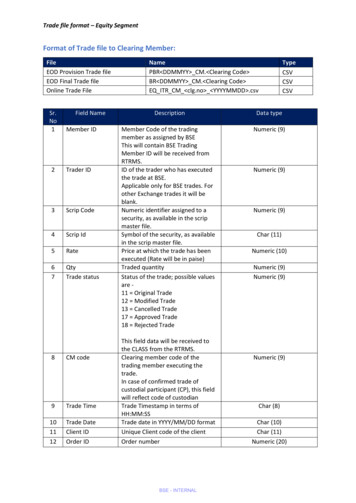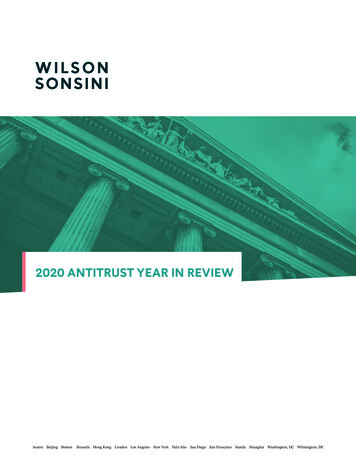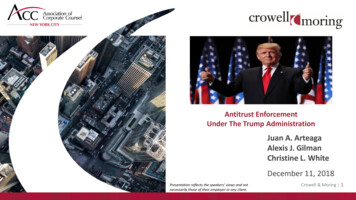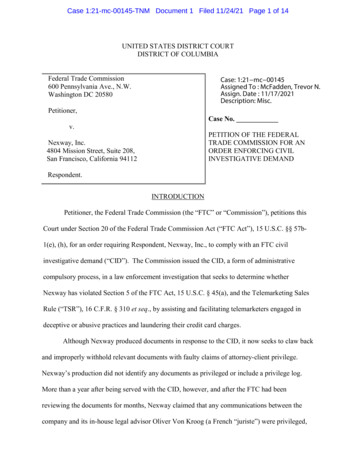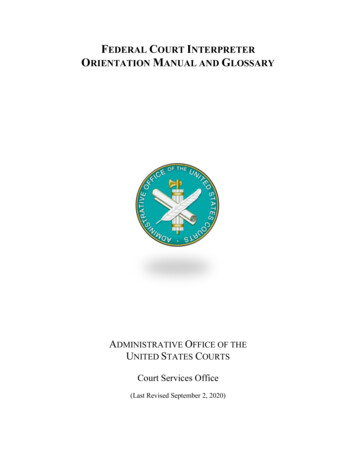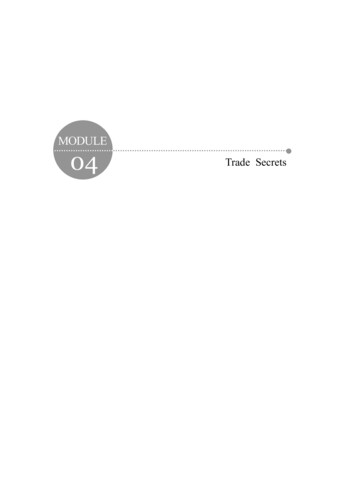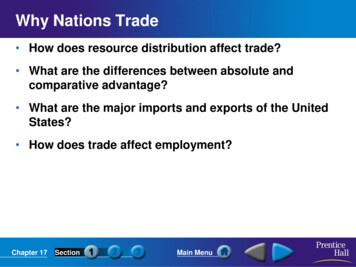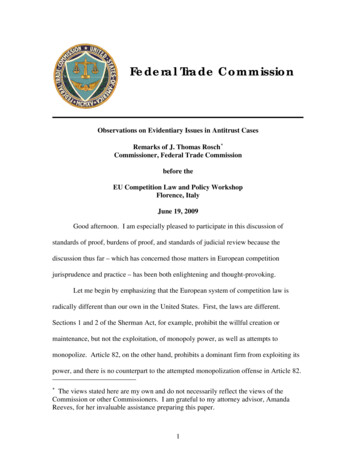
Transcription
Federal Trade CommissionObservations on Evidentiary Issues in Antitrust CasesRemarks of J. Thomas Rosch Commissioner, Federal Trade Commissionbefore theEU Competition Law and Policy WorkshopFlorence, ItalyJune 19, 2009Good afternoon. I am especially pleased to participate in this discussion ofstandards of proof, burdens of proof, and standards of judicial review because thediscussion thus far – which has concerned those matters in European competitionjurisprudence and practice – has been both enlightening and thought-provoking.Let me begin by emphasizing that the European system of competition law isradically different than our own in the United States. First, the laws are different.Sections 1 and 2 of the Sherman Act, for example, prohibit the willful creation ormaintenance, but not the exploitation, of monopoly power, as well as attempts tomonopolize. Article 82, on the other hand, prohibits a dominant firm from exploiting itspower, and there is no counterpart to the attempted monopolization offense in Article 82. The views stated here are my own and do not necessarily reflect the views of theCommission or other Commissioners. I am grateful to my attorney advisor, AmandaReeves, for her invaluable assistance preparing this paper.1
Second, we have different histories and cultures. For example, until recently theUnited States had fewer state-owned enterprises than Europe has had (although that gapmay be narrowing substantially, given our federal government’s intervention in thebanking, insurance and automobile sectors). Concomitantly, state aid had historicallybeen less closely scrutinized in the United States than in Europe (although that gap maynarrow too, as government investments become more prevalent in the United States).Third, it is arguable that the United States and Europe analyze antitrust questionsagainst a backdrop of different economic principles. Damien Nevins may disagree withme, but I have remarked before that Europe seems more open to embracing post-ChicagoSchool theories of rational, but predatory, conduct like practices designed to raise rivals’costs and/or to exclude rivals’ cheaply. 1 Europe may also more warmly embrace some ofthe “new” economics like experimental economics or behavioral economics.2 At leastsome of the most provocative discussions I’ve seen on those subjects recently haveemanated from Europe.Fourth, and most fundamentally, we have very different enforcement regimes. Inthe United States, we have private, as well as public, enforcement. Although Ms. Kroes1See J. Thomas Rosch, “I say Monopoly, You say Dominance: The Continuing Divideon the Treatment of Dominant Firms, is it the Economics?” (September 8, 2007),available at lyiba.pdf; J. ThomasRosch, “Has the Pendulum Swung Too Far: Some Reflections on U.S. and ECJurisprudence” (June 25, 2007), available .pdf.2See, e.g., Maurice E. Stucke, New Antitrust Realism, Global Competition Policy(January 2009); Maurice E. Stucke, Behavioral Economics at the Gate: Antitrust in theTwenty-First Century, 38 Loy. U. Chi. L. J. 513 (Spring 2007); Joseph Farrell,Complexity, Diversity, and Antitrust, 51 Antitrust Bull. 165 (Spring 2006); see generally,J. Thomas Rosch, “Antitrust Law Enforcement: What to Do About the CurrentEconomics Cacophony?” (June 1, 2009), available te.pdf (discussing different schools ofeconomic thought).2
has recently taken some tentative steps toward initiating private litigation in Europe, itremains far from clear (especially given the U.K.’s recent rejection of class actionlitigation) how far that initiative will proceed. Personally, in view of Europe’s antipathytoward opt-out class actions and toward pretrial discovery and the potential for abuses ofboth in the United States, I am dubious about whether Europe can – or should – emulatethe United States in this respect.Beyond that, our system of public enforcement in the United States is anadversarial system: the Justice Department and the state attorneys’ general mustprosecute their challenges brought under federal antitrust law in the federal courts.Indeed, even the FTC, which acts as both a prosecutor and judge, must use administrativelaw judges in administrative proceedings and make requests for preliminary injunctionsin the federal courts. The federal courts and administrative law judges are allindependent fact-finders, and their fact-finding processes include vigorous crossexamination and are subject to judicial review.By contrast, the system of public enforcement in Europe is administrative: to theconsternation and dismay of experienced practitioners like Jim Venit, Mario Saragossa,and Ian Forrester, the Commission (and its counterparts in the member states) not onlyact as prosecutor and judge, but make decisions without cross-examination and withostensibly limited judicial review. This may make the EC more concerned about underenforcement as compared with the EC’s counterparts in the United States. Moreover, asPhilip Lowe and Claus-Dieter Ehlermann have observed, Europe is not going to abandonthat administrative system anytime soon.3
Yet, despite these radical differences between Europe and the United States, I amstruck by the fact that the issues raised regarding our competition law enforcementregimes are remarkably similar. Of course the reason we are discussing standards ofproof, burdens of proof, and standards of judicial review today is because they were onour agenda. But these are the very same questions that we are discussing in the UnitedStates with regard to our adversarial system of competition law enforcement.Before I go further, though, please let me define what those terms mean to me. Tome, the “burden of proof” means the standard of production. That is to say, it refers towho has the burden of producing evidence on a substantive element of an offense (or ofproducing evidence on a substantive element of a defense). Necessarily, then, who hasthat burden depends on the elements of the offense (or the defense), and whether theburden of production of that element has shifted in a particular case. Thus, whether anoffense is a per se offense, a full-blown rule of reason offense, or a truncated rule ofreason offense makes a difference in determining the applicable burden of proof.On the other hand, the “standard of proof” refers in my mind to the probativevalue of the evidence. At today’s sessions, for example, other contributors have madereference to three possible measurements of the probative value of the evidence: (1)preponderance of the evidence, which really just requires that the party bearing theburden of proof show that it is more probable than not that it has met the standard ofproof it bears; (2) proof by clear and convincing evidence, which requires more probativeevidence than the preponderance measurement requires; and (3) proof beyond areasonable doubt, which requires still more probative evidence and is normally applicableonly in cases involving per se illegality (like price-fixing).4
The “standard of judicial review” refers, by contrast, to the degree of deferencethat an appellate court accords to the decision of a competition court or agency. That canrange all the way from being a “rubber stamp” and automatically blessing the court oragency decision to reviewing the applicable facts and law de novo. Some of thepractitioners that we have heard from today have asserted that, in reviewing the EC’sdecisions, whether those decisions concern liability or the amount of a fine, the CFIand/or the European court have accorded the EC too much deference.But, again, I am struck by the fact that, whatever the differences in thedistribution of burdens of proof, standards of proof, and standards of judicial reviewapplicable in particular cases in the United States and Europe, the application of thoseconcepts in similar cases is remarkably similar. Please don’t misunderstand me. I havesaid before – and I’ll say it again – that I don’t think that substantive convergence ispossible anytime soon. The differences in the laws, histories, cultures, economics, and inthe law enforcement regimes is too pronounced for that. Indeed, I don’t think that truecomity is possible anytime soon. Comity is already accorded in easy cases, where onecountry is less interested in a matter than in another. But in the hard cases – wheremultiple countries assert an interest – comity is less likely.That said, however, as I say, the application of the three concepts in similar casesis remarkably similar. One can see that most vividly in cases involving conduct (likeprice-fixing) that is considered to be per se illegal under both Section 1 of the ShermanAct and Article 81. The challenge for a defendant to win those cases in the first instanceor on appeal is daunting.5
However, one can see the same phenomenon in Section 2 and Article 82 cases.Under the recent EC Guidance, liability under Article 82 turns on the effects of thedominant firm’s conduct. The same thing is true of recent Section 2 cases decided by theregional federal appellate courts in the United States – cases like Dentsply, LePage’s,Microsoft, Spirit Airlines, and Conwood 3 (though not, as Barry Hawk has reminded us ofSupreme Court Section 2 cases) 4 .To illustrate this point, I would like to ask a series of four questions, discuss whatthe answers would be in the United States and then ask whether the answer would bedifferent in Europe, based on what I’ve read and heard.First, does the prospect of liability differ, depending on whether the conduct atissue is a merger or single-firm conduct? I regard this as a question raising the issuewhether the applicable standard of proof and the standard of review are the same in casesinvolving these two types of conduct. Lorenzo Coppi has suggested, for example, thatless deference should be paid to prosecutors if single-firm conduct is involved because ofthe need for certainty respecting the legality or illegality of that conduct. But I don’tdiscern any real difference in the applicable standard of proof or in judicial review ofprosecutorial decisions in cases involving the two kinds of conduct in the United States orEurope.In the United States, the Supreme Court has not decided any merger cases indecades so no conclusions can be drawn from Supreme Court merger jurisprudence. But3United States v. Dentsply Int’l Inc., 399 F.3d 181 (3d Cir. 2005); LePage’s Inc. v. 3MCorp., 324 F.3d 141 (3d Cir. 2003); United States v. Microsoft Corp., 253 F.3d 34 (D.C.Cir. 2001); Spirit Airlines v. Northwest Airlines, 431 F.3d 917 (6th Cir. 2005); ConwoodCo., L.P. v. U.S. Tobacco Co., 290 F.3d 768 (6th Cir. 2002).4See, e.g., Pac. Bell Tel. Co. v. linkLine Commc’ns, Inc., 129 S.Ct. 1109 (2009); VerizonCommunications v. Law Offices of Curtis V. Trinko, LLP, 540 U.S. 398 (2004).6
the regional federal appellate courts in the United States, as well as the CFI and the ECJ,have conducted searching inquiries into prosecutorial positions respecting mergers. See,for example, the decisions in Baker Hughes (where DOJ lost) 5 and the CFI decision inCruise Lines (where the EC lost). That is arguably because the inquiry in those cases wasprospective, involving the need for predictions, instead of retrospective, where there is noneed to predict what will happen because it has happened. I suggested in a concurrencein the Evanston Hospital case that that makes a difference; 6 appellate courts seem todemand more from the prosecutors where predictions are required.On the other hand, in both the United States and in Europe, the regional courts ofappeals have been pretty deferential to the prosecutors in recent single-firm conductcases. Dentsply and Microsoft are examples in the United States. 7 Microsoft, BritishAirways, and France Telecom are examples in Europe. 8 That is arguably because in theUnited States the practices at issue have been challenged under Section 2 of the ShermanAct, and therefore, by definition, were employed by firms with monopoly or nearmonopoly power. Similarly, in the European cases the challenges were made underArticle 82, and therefore, by definition, were employed by “dominant” firms. Appellatecourts seem to demand less of prosecutors in terms of showing that the practices are5See United States v. Baker Hughes, Inc., 908 F.2d 981 (D.C. Cir. 1990).6In the Matter of Evanston Northwestern Healthcare Corp., FTC Dkt. No. 9315,Concurring Statement of Comm’r J. Thomas Rosch, available df.7Dentsply, 399 F.3d 181; Microsoft Corp., 253 F.3d 34.8See, e.g., Microsoft v. Commission, Case T-201/04, 2007 ECR II-000, 5 C.M.L.R. 846(CFI 2007); British Airways P.L.C. v. Commission of the European Communities, CaseT-219/99, 2003 E.C.R. II-5917 (CFI 2003); France Télécom SA v. Commission of theEuropean Communities, Case T-340/03, 2007 E.C.R. II-107 (CFI 2007).7
“exclusionary” in effect when the practices are employed by firms of that kind than whenthey are employed by less powerful firms.Second, does the analysis of liability differ depending on whether justificationslike efficiencies are offered for the conduct? I regard this as a question that relatesprimarily to the burden of proof (or the burden of production of evidence). In the UnitedStates, the courts have uniformly held that certain conduct like naked price-fixingagreements or agreements dividing customers or territories are illegal per se and cannotbe justified. The European case law appears to be to the same effect. In cases whereprosecutors have borne their burden of producing evidence of agreements, they havewon; when they have not borne that burden, they have lost.By contrast, in “full blown rule of reason” cases in the United States, a public orprivate prosecutor bears the burden of producing evidence both that the conduct hasanticompetitive effects and that those effects outweigh any pro-competitive effects oreffects that are competitively benign. 9 Again, in cases when the prosecutors have bornethe burden of producing evidence of both elements, they have generally won; when theyhave not, they have generally lost. The same appears to be true in Europe.Then there is a third class of rule of reason cases. In the United States, they arecalled “truncated rule of reason” or “quick look” cases. The “truncated” or “quick look”analysis applies to transactions or practices that are anticompetitive on their face unlessjustified by efficiencies or otherwise. Judge Ginsburg of the United States Court ofAppeals for the D.C. Circuit has called such transactions or practices “inherently9See, e.g., Continental T.V., Inc. v. GTE Sylvania Inc., 433 U.S. 36 (1977) (abandoningthe per se rule against non-price vertical restraints and applying the rule of reason).8
suspect.” 10 In his Three Tenors opinion he held that the burden of producing evidence tojustify them shifted to the defendant(s); if the defendant failed to produce that evidence, itwould lose. The CFI’s decision in the Microsoft case (and the EC’s recent Article 82Guidance) seem to embrace that analysis. 11Finally, on this point, both the United States federal public enforcement agencies(the DOJ and FTC) and the EC have adopted this burden-shifting analysis. The UnitedStates agencies’ Joint Horizontal Merger Guidelines and the EC’s Horizontal MergerGuidance both provide that the defendant – not the prosecuting agency – bears the burdenof proving efficiencies in order to justify an otherwise anticompetitive merger is on thedefendant, not the prosecuting agency. 12 That seems appropriate since the parties arelikely to have knowledge on this score that is superior to that of the agencies.Third, what weight is given to economic analyses in reaching liabilityconclusions? This is a question primarily related to the standard of proof (having to dowith the probative value of evidence and the standard of review). Frankly, I think therewas pretty close to a consensus at this Conference among practitioners and economistswho were commentators about this subject, and those commentators came from both10Polygram Holding, Inc. v. FTC, 416 F.3d 29 (D.C. Cir. 2005)(Ginsburg, J.). Morerecently, the Fifth Circuit has also applied the truncated rule of reason in North TexasSpecialty Physicians v. FTC, 528 F.3d 346 (5th Cir. 2008).11See Case T-201/04, Microsoft v. Comm’n, 2007 ECJ CELEX LEXIS 554 (Sept. 14,2007); European Commission Communication – Guidance on The Commission’sEnforcement Priorities In Applying Article 82 EC Treaty to Abusive ExclusionaryConduct By Dominant Undertakings The Guidance (“EC Guidance”), titrust/art82/index.html.12See Horizontal Merger Guidelines, § 4 & n. 5 (“For example, the burden with respectto efficiency and failure continues to reside with the proponents of the merger.”); supranote 11, EC Guidance at 12-13 (discussing use of evidence of efficiencies as a defense toa claim of exclusionary conduct).9
sides of the Atlantic. Although the initial focus was on the conflict among economiststhat sometimes cancel out each other’s opinions, Simon Bishop and Lorenzo Coppiseemed to agree that the more fundamental problem with many economic analyses is thatthey are too complex and therefore are incomprehensible. Based on my own experience,that is especially true of simulation studies and regression analyses that involve complexformulae requiring an economist’s knowledge of statistics.By contrast, there seemed to be agreement that direct evidence of the effects of atransaction or practice in the form of a party’s own statements or documents is superior tothose formulae in terms of their probative value.13 That also seemed to be true of theexplanation by an economist of his or her assumptions and conclusions. Everyoneseemed to agree that federal judges, as well as members of the European courts, aregenerally not Ph.D. economists, and that this kind of evidence is more likely to beprobative when there is judicial review of prosecutorial challenges. 14 Indeed, it does not13Indeed, in the U.S., in cases brought under the Sherman Act, the courts areincreasingly focused on direct evidence of competitive effects to determine thelawfulness of completed or ongoing conduct. See, e.g., FTC v. Indiana Federation ofDentists, 476 U.S. 447 (1986) (“IFD”); Conwood Co., L.P. v. United States Tobacco Co.,290 F.3d 768, 783 n.2 (6th Cir. 2002) (“Whether a company has monopoly or marketpower ‘may be proven directly by evidence of the control of prices or the exclusion ofcompetition . .’”); Microsoft, 253 F.3d at 51 (stating that in a Section 2 case, if“evidence indicates that a firm has in fact [profitably raised prices substantially above thecompetitive level], the existence of monopoly power is clear.”); Tops Markets, Inc. v.Quality Markets, Inc., 142 F.3d 90, 98 (2d Cir. 1993) (market power “may be provendirectly by evidence of the control of prices or the exclusion of competition, or it may beinferred from one firm's large percentage share of the relevant market.”); Todd v. ExxonCorp., 275 F.3d 191, 207 (2d Cir. 2001) (“use of anticompetitive effects to demonstratemarket power . . . is not limited to ‘quick look’ or ‘truncated’ rule of reason cases”).14See generally Vaughn R. Walker, Merger Trials: Looking for the Third Dimension, 5Competition Policy International 1 (Spring 2009) (arguing that generalist judges lackeconomic training (and often interest) and that, as such, if economic evidence is to bepersuasive, it must be communicated in a way that a generalist can understand and mustbe consistent with other evidence).10
appear that complex economic analysis has carried the day in many (if any) appeals in theUnited States or Europe.Fourth, what weight is given to evidence of intent and/or to evidence of multiplepotentially exclusionary practices employed by defendants in Sherman Act and Article81/ 82 cases? Again, this is a question that goes to the standard of proof (the probativevalue of evidence) and to the standard of review. In the United States, the case lawteaches that the ultimate focus in a Sherman Act case is on the effects of a transaction orpractice, and that evidence of intent is relevant to illuminate effects but not otherwise. 15Put differently, evidence of an intent to achieve certain anticompetitive effects isprobative, but evidence of an intent to compete is not. 16 Indeed, as the United StatesCourt of Appeals for the First Circuit has put it, “motive can, of course, be a guide toexpected effects, but effects are still the central concern of the antitrust laws, and motiveis mainly a clue.” 17 The case law in the EC seems to be consistent with this teaching,although perhaps not quite so explicitly.15See United States v. Microsoft, 253 F.3d 34, 59 (D.C. Cir. 2001) (“Evidence of theintent behind the conduct of a monopolist is relevant only to the extent it helps usunderstand the likely effect of the monopolist’s conduct); Chicago Bd. of Trade v. UnitedStates, 246 U.S. 231, 238 (1918) (“knowledge of intent may help the court to interpretfacts and to predict consequences”); Aspen Skiing Co. v. Aspen Highlands Skiing Corp.,472 U.S. 585 (1985)”).16Found. for Interior Design Educ. Research v. Savannah Coll. of Art & Design, 244F.3d 521, 532 (6th Cir. 2001) (without pleading and proof of market power and antitrustinjury, allegation of an unlawful purpose is insufficient to state a claim); CaliforniaDental Assoc. v. FTC, 244 F.3d 942, 948 (9th Cir. 2000) (“while ‘smoking gun’ evidenceof an intent to restrain competition remains relevant to . . . discerning the competitiveconsequences of a defendant’s actions,” intent is insufficient to prove liability under therule of reason); Levine v. Central Fla. Med. Affiliates, 72 F.3d 1538, 1552 (11th Cir.1996) (“the rule of reason analysis is concerned with the actual or likely effects ofdefendants’ behavior, not with the intent behind the behavior”).17U.S. Healthcare v. Healthsource, Inc., 986 F.2d 589, 596 (1st Cir. 1993).11
Similarly, the case law in the United States seems to draw a distinction between“bathtub conspiracy” cases (where public or private plaintiffs seek to establish liabilitybased on multiple acts, most of which are not illegal) and cases in which a liability claimis founded on evidence of multiple potentially illegal practices. Evidence of the formerkind has been held by some courts not to be probative on the theory that “zero plus zerocannot equal one.” On the other hand, United States courts have considered evidence ofmultiple potentially illegal acts to be probative. The decisions in Microsoft and LePage’sare examples. The case law in Europe is unequivocally to the effect that such evidence isprobative of liability as well.One question remains: why do we see such similarities, given the very substantialdifferences in our competition laws and law enforcement regimes? I don’t have theanswer to that. Perhaps it is because, as Judge Vaughn Walker has said, Europe and theUnited States share a common “lodestar” in competition law that is called “consumerwelfare (and, it might be added, a common focus on the effects of a transaction orpractice as opposed to focusing on more subjective matters).Or, perhaps it is because the appellate courts are reluctant to second-guess triersof fact like federal district judges, administrative law judges, or even the EC who haveseen witnesses personally and are better able to assess their credibility as fact witnesses(although that would just explain why appellate courts are willing to be deferential as tothe facts, not as to the law). And, it would better explain the United States appellate caselaw, than the European appellate case law, given that the EC process is not adversarial asit is in the United States.12
Or, perhaps, as some of the practitioner commentators have asserted, it is becausethe appellate courts greatly respect prosecutors like the DOJ, FTC and EC who haveextensive expertise and experience in enforcing competition laws.Or, perhaps it is some combination of these factors. All I know is that, as I say, itseems to me there is a remarkable degree of similarity in application of the burden ofproof, the standard of proof, and the standard of judicial review in competition cases inEurope and the United States.13
banking, insurance and automobile sectors). Concomitantly, state aid had historically been less closely scrutinized in the United States than in Europe (although that gap m narrow too, as government investments become more prevalent in the United States). Third, it is arguable that the United States and Europe analyze antitrust questions
